Recognising and Analysing Latest Trends in Data Warehousing, BI, and Data Mining
VerifiedAdded on 2023/01/11
|7
|1599
|44
AI Summary
This study explores the recent trends in data warehousing, business intelligence (BI), and data mining. It discusses augmented analytics, plug n' play analytics solutions, clear and descriptive visualization of data, NLP driven analytical queries, time series data mining, ubiquitous data mining, distributed data mining, data warehouse migrating to cloud, hybrid data management, and data lake reboot. The study also highlights the importance of recognizing and adopting these trends for organizations in various sectors.
Contribute Materials
Your contribution can guide someone’s learning journey. Share your
documents today.

Data Handling
And
Business Intelligence.
And
Business Intelligence.
Secure Best Marks with AI Grader
Need help grading? Try our AI Grader for instant feedback on your assignments.
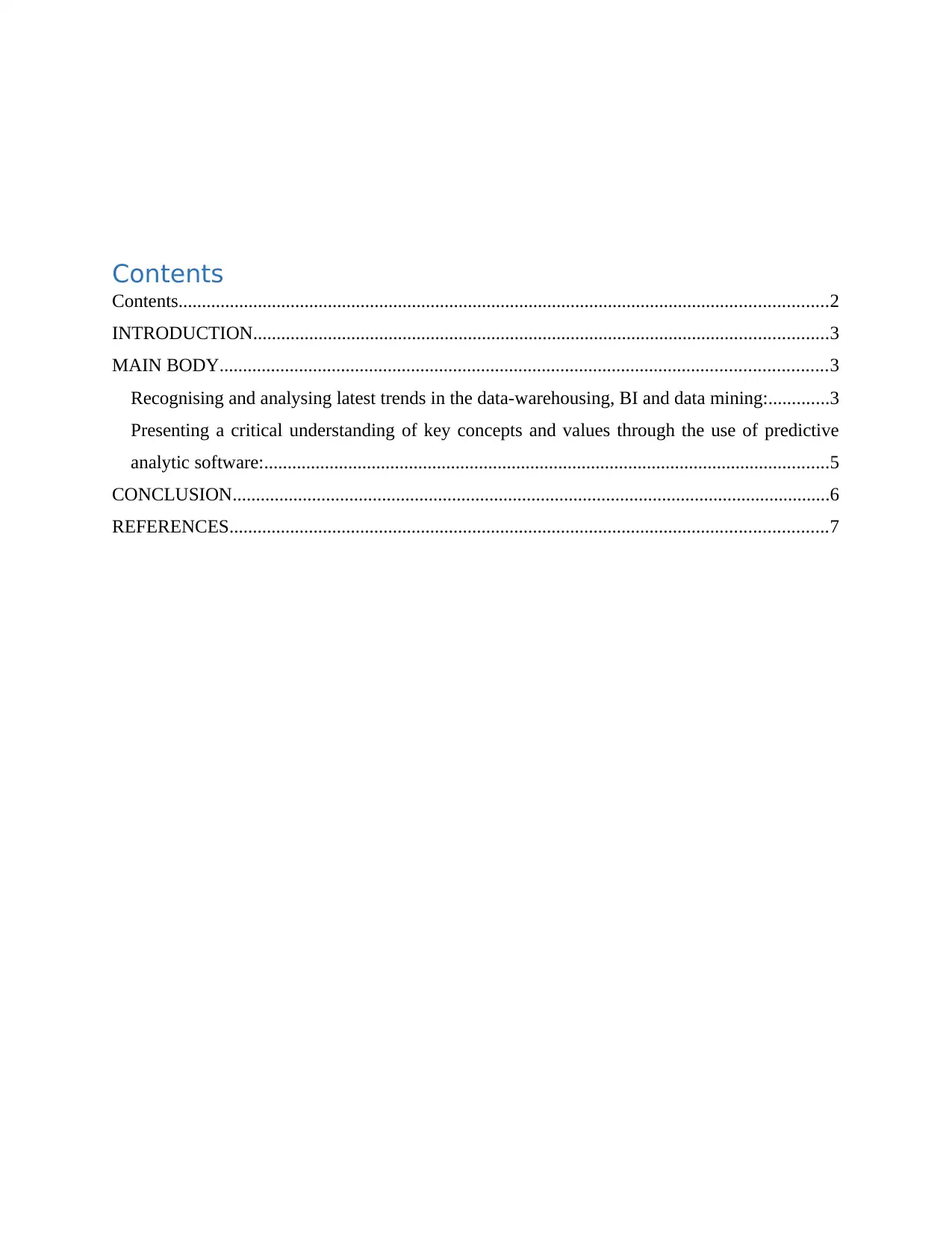
Contents
Contents...........................................................................................................................................2
INTRODUCTION...........................................................................................................................3
MAIN BODY..................................................................................................................................3
Recognising and analysing latest trends in the data-warehousing, BI and data mining:.............3
Presenting a critical understanding of key concepts and values through the use of predictive
analytic software:.........................................................................................................................5
CONCLUSION................................................................................................................................6
REFERENCES................................................................................................................................7
Contents...........................................................................................................................................2
INTRODUCTION...........................................................................................................................3
MAIN BODY..................................................................................................................................3
Recognising and analysing latest trends in the data-warehousing, BI and data mining:.............3
Presenting a critical understanding of key concepts and values through the use of predictive
analytic software:.........................................................................................................................5
CONCLUSION................................................................................................................................6
REFERENCES................................................................................................................................7
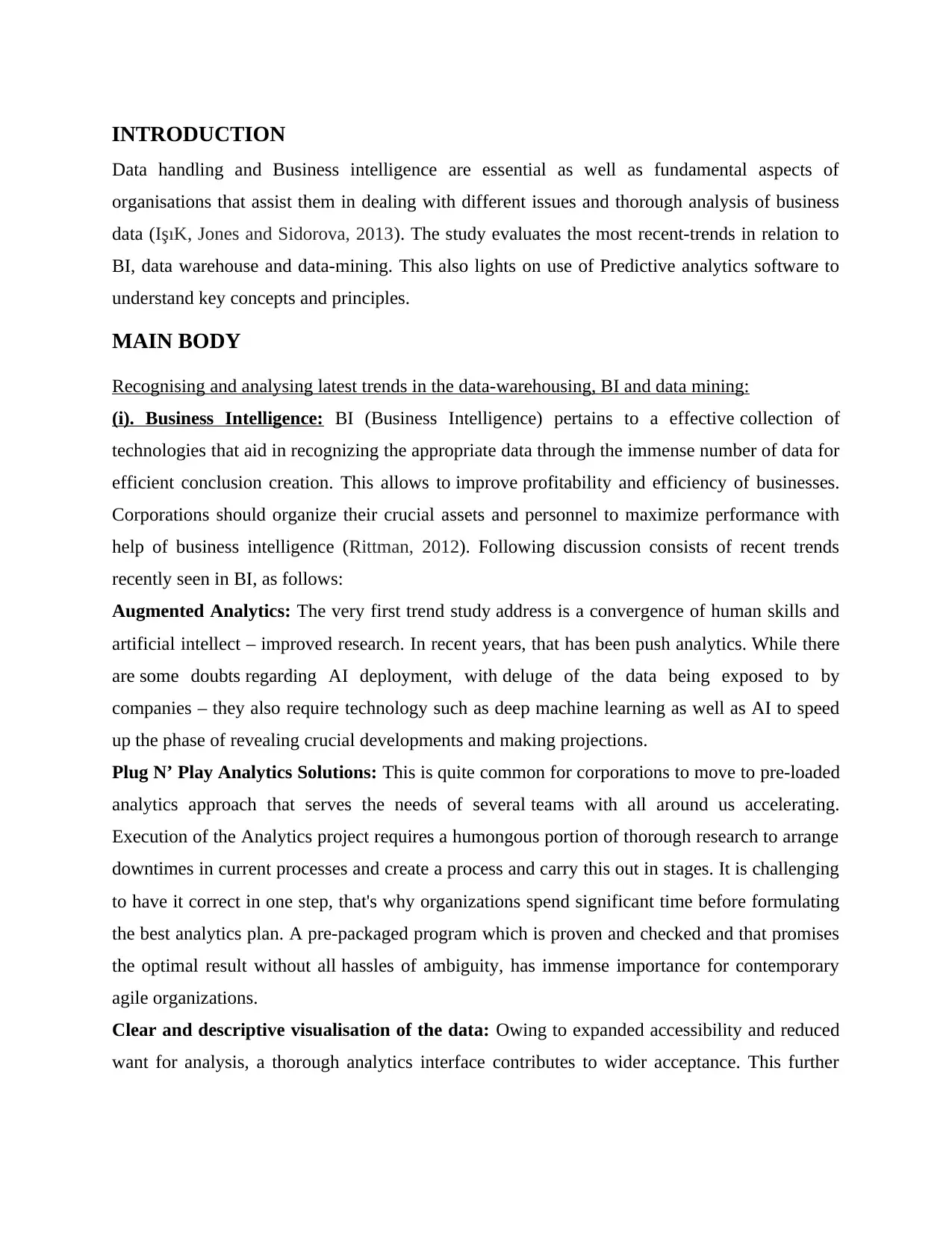
INTRODUCTION
Data handling and Business intelligence are essential as well as fundamental aspects of
organisations that assist them in dealing with different issues and thorough analysis of business
data (IşıK, Jones and Sidorova, 2013). The study evaluates the most recent-trends in relation to
BI, data warehouse and data-mining. This also lights on use of Predictive analytics software to
understand key concepts and principles.
MAIN BODY
Recognising and analysing latest trends in the data-warehousing, BI and data mining:
(i). Business Intelligence: BI (Business Intelligence) pertains to a effective collection of
technologies that aid in recognizing the appropriate data through the immense number of data for
efficient conclusion creation. This allows to improve profitability and efficiency of businesses.
Corporations should organize their crucial assets and personnel to maximize performance with
help of business intelligence (Rittman, 2012). Following discussion consists of recent trends
recently seen in BI, as follows:
Augmented Analytics: The very first trend study address is a convergence of human skills and
artificial intellect – improved research. In recent years, that has been push analytics. While there
are some doubts regarding AI deployment, with deluge of the data being exposed to by
companies – they also require technology such as deep machine learning as well as AI to speed
up the phase of revealing crucial developments and making projections.
Plug N’ Play Analytics Solutions: This is quite common for corporations to move to pre-loaded
analytics approach that serves the needs of several teams with all around us accelerating.
Execution of the Analytics project requires a humongous portion of thorough research to arrange
downtimes in current processes and create a process and carry this out in stages. It is challenging
to have it correct in one step, that's why organizations spend significant time before formulating
the best analytics plan. A pre-packaged program which is proven and checked and that promises
the optimal result without all hassles of ambiguity, has immense importance for contemporary
agile organizations.
Clear and descriptive visualisation of the data: Owing to expanded accessibility and reduced
want for analysis, a thorough analytics interface contributes to wider acceptance. This further
Data handling and Business intelligence are essential as well as fundamental aspects of
organisations that assist them in dealing with different issues and thorough analysis of business
data (IşıK, Jones and Sidorova, 2013). The study evaluates the most recent-trends in relation to
BI, data warehouse and data-mining. This also lights on use of Predictive analytics software to
understand key concepts and principles.
MAIN BODY
Recognising and analysing latest trends in the data-warehousing, BI and data mining:
(i). Business Intelligence: BI (Business Intelligence) pertains to a effective collection of
technologies that aid in recognizing the appropriate data through the immense number of data for
efficient conclusion creation. This allows to improve profitability and efficiency of businesses.
Corporations should organize their crucial assets and personnel to maximize performance with
help of business intelligence (Rittman, 2012). Following discussion consists of recent trends
recently seen in BI, as follows:
Augmented Analytics: The very first trend study address is a convergence of human skills and
artificial intellect – improved research. In recent years, that has been push analytics. While there
are some doubts regarding AI deployment, with deluge of the data being exposed to by
companies – they also require technology such as deep machine learning as well as AI to speed
up the phase of revealing crucial developments and making projections.
Plug N’ Play Analytics Solutions: This is quite common for corporations to move to pre-loaded
analytics approach that serves the needs of several teams with all around us accelerating.
Execution of the Analytics project requires a humongous portion of thorough research to arrange
downtimes in current processes and create a process and carry this out in stages. It is challenging
to have it correct in one step, that's why organizations spend significant time before formulating
the best analytics plan. A pre-packaged program which is proven and checked and that promises
the optimal result without all hassles of ambiguity, has immense importance for contemporary
agile organizations.
Clear and descriptive visualisation of the data: Owing to expanded accessibility and reduced
want for analysis, a thorough analytics interface contributes to wider acceptance. This further
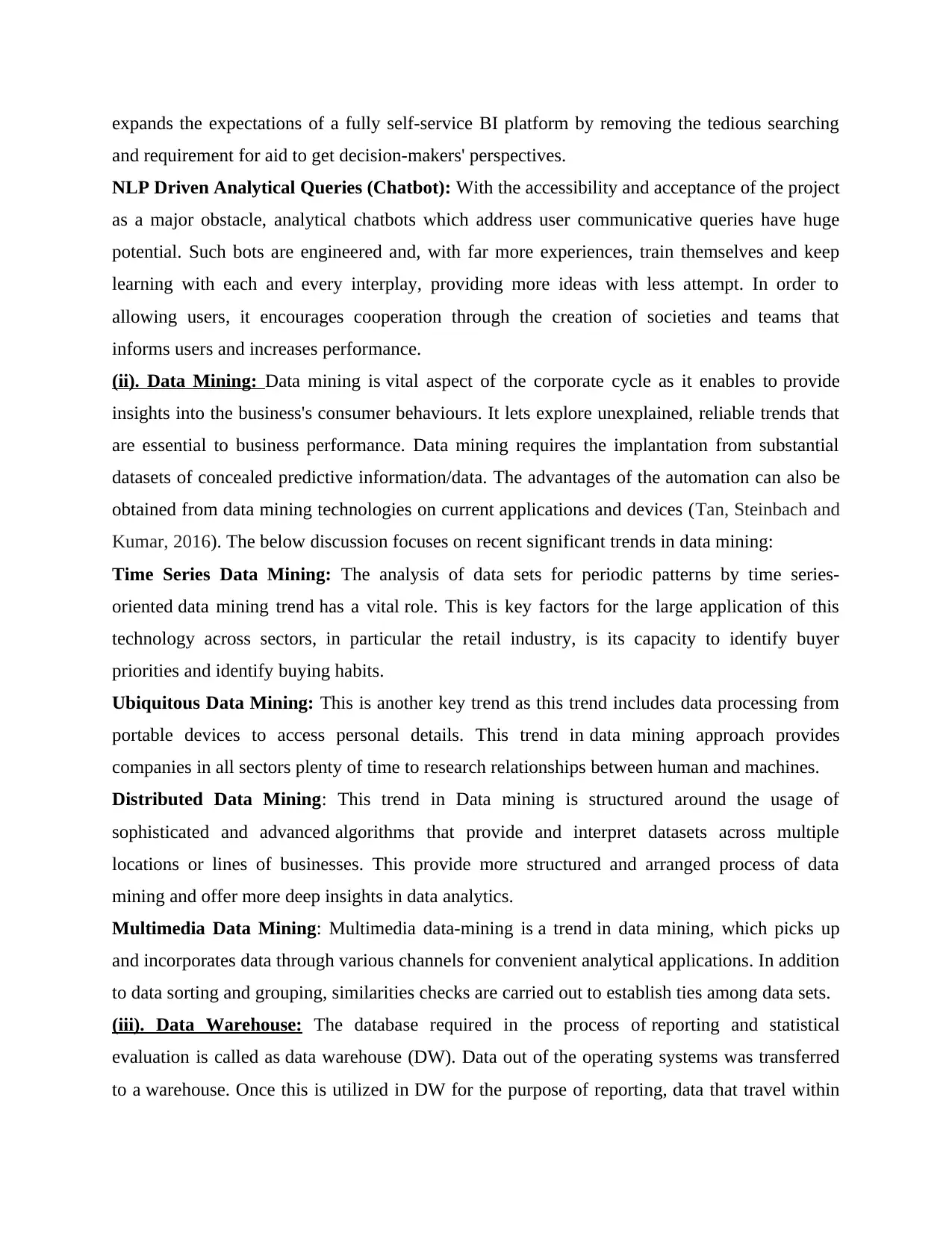
expands the expectations of a fully self-service BI platform by removing the tedious searching
and requirement for aid to get decision-makers' perspectives.
NLP Driven Analytical Queries (Chatbot): With the accessibility and acceptance of the project
as a major obstacle, analytical chatbots which address user communicative queries have huge
potential. Such bots are engineered and, with far more experiences, train themselves and keep
learning with each and every interplay, providing more ideas with less attempt. In order to
allowing users, it encourages cooperation through the creation of societies and teams that
informs users and increases performance.
(ii). Data Mining: Data mining is vital aspect of the corporate cycle as it enables to provide
insights into the business's consumer behaviours. It lets explore unexplained, reliable trends that
are essential to business performance. Data mining requires the implantation from substantial
datasets of concealed predictive information/data. The advantages of the automation can also be
obtained from data mining technologies on current applications and devices (Tan, Steinbach and
Kumar, 2016). The below discussion focuses on recent significant trends in data mining:
Time Series Data Mining: The analysis of data sets for periodic patterns by time series-
oriented data mining trend has a vital role. This is key factors for the large application of this
technology across sectors, in particular the retail industry, is its capacity to identify buyer
priorities and identify buying habits.
Ubiquitous Data Mining: This is another key trend as this trend includes data processing from
portable devices to access personal details. This trend in data mining approach provides
companies in all sectors plenty of time to research relationships between human and machines.
Distributed Data Mining: This trend in Data mining is structured around the usage of
sophisticated and advanced algorithms that provide and interpret datasets across multiple
locations or lines of businesses. This provide more structured and arranged process of data
mining and offer more deep insights in data analytics.
Multimedia Data Mining: Multimedia data-mining is a trend in data mining, which picks up
and incorporates data through various channels for convenient analytical applications. In addition
to data sorting and grouping, similarities checks are carried out to establish ties among data sets.
(iii). Data Warehouse: The database required in the process of reporting and statistical
evaluation is called as data warehouse (DW). Data out of the operating systems was transferred
to a warehouse. Once this is utilized in DW for the purpose of reporting, data that travel within
and requirement for aid to get decision-makers' perspectives.
NLP Driven Analytical Queries (Chatbot): With the accessibility and acceptance of the project
as a major obstacle, analytical chatbots which address user communicative queries have huge
potential. Such bots are engineered and, with far more experiences, train themselves and keep
learning with each and every interplay, providing more ideas with less attempt. In order to
allowing users, it encourages cooperation through the creation of societies and teams that
informs users and increases performance.
(ii). Data Mining: Data mining is vital aspect of the corporate cycle as it enables to provide
insights into the business's consumer behaviours. It lets explore unexplained, reliable trends that
are essential to business performance. Data mining requires the implantation from substantial
datasets of concealed predictive information/data. The advantages of the automation can also be
obtained from data mining technologies on current applications and devices (Tan, Steinbach and
Kumar, 2016). The below discussion focuses on recent significant trends in data mining:
Time Series Data Mining: The analysis of data sets for periodic patterns by time series-
oriented data mining trend has a vital role. This is key factors for the large application of this
technology across sectors, in particular the retail industry, is its capacity to identify buyer
priorities and identify buying habits.
Ubiquitous Data Mining: This is another key trend as this trend includes data processing from
portable devices to access personal details. This trend in data mining approach provides
companies in all sectors plenty of time to research relationships between human and machines.
Distributed Data Mining: This trend in Data mining is structured around the usage of
sophisticated and advanced algorithms that provide and interpret datasets across multiple
locations or lines of businesses. This provide more structured and arranged process of data
mining and offer more deep insights in data analytics.
Multimedia Data Mining: Multimedia data-mining is a trend in data mining, which picks up
and incorporates data through various channels for convenient analytical applications. In addition
to data sorting and grouping, similarities checks are carried out to establish ties among data sets.
(iii). Data Warehouse: The database required in the process of reporting and statistical
evaluation is called as data warehouse (DW). Data out of the operating systems was transferred
to a warehouse. Once this is utilized in DW for the purpose of reporting, data that travel within
Paraphrase This Document
Need a fresh take? Get an instant paraphrase of this document with our AI Paraphraser

an organizational data storage for added activities (Krishnan, 2013). Here in below discussion
multiple trends in data warehouse has been evaluated thoroughly, as follows:
Data warehouse migrating to cloud: Hadoop has been biggest trend in data-warehousing over
the last few years. Most businesses had Hadoop deployed on premise and still encounter rising
running expenses and barriers to align with cloud-based applications. The 2019 pattern is for
businesses to transfer data centres to the cloud to run at a reduced cost and with better efficiency
and interoperability.
Hybrid data management: On-site technologies will not quickly be gone, and businesses would
have to decide whether to cohabit and interoperate both on-site and cloud info. Many
organizations cope with this by retaining their central, report-oriented data stores on site to deter
effects for end-users, thus transferring data collection, relevant data for operational purposes and
others into a cloud system.
Data lake reboot: In the last five years, they have been overwhelmed with the unstructured
complexity of the data lakes as market consumers and others gazed at versatility of being clear of
the limitations of association data structures. Previously (and smaller) data lakes appeared to be
the ideal option for agile companies. Nonetheless, the strategic edge that businesses have
discovered includes a degree of organization and the reality that these data lakes easily become
confusion.
Presenting a critical understanding of key concepts and values through the use of predictive
analytic software:
Predictive analytics refers to mathematical and statistical method for evaluating past and present
knowledge in attempt to ensure a fair projection of the future. The predictive analytics
software is used by companies to define industry patterns, threats and challenges in a company
setting. Enterprises may identify possible challenges as well as opportunities for gain sustainable
business gains by predictive analysis. Predictive analysis was often part of mining of data that
concentrates on collecting data from past data to forecast behavioural behaviours and tendencies.
In general, any form of unpredictable occurrences may be forecast using predictive analytics to
assess current and potential occurrences. Banks are first to follow the software of predictive
analytics. Banking institutions use credit and loans data to assess the possibility of individual
applying for bank loan (Bro, 2017). The system has helped banking institutions reduce losses by
identifying applicants that might be bank loans defaulting. For the tracking of patterns and risk
multiple trends in data warehouse has been evaluated thoroughly, as follows:
Data warehouse migrating to cloud: Hadoop has been biggest trend in data-warehousing over
the last few years. Most businesses had Hadoop deployed on premise and still encounter rising
running expenses and barriers to align with cloud-based applications. The 2019 pattern is for
businesses to transfer data centres to the cloud to run at a reduced cost and with better efficiency
and interoperability.
Hybrid data management: On-site technologies will not quickly be gone, and businesses would
have to decide whether to cohabit and interoperate both on-site and cloud info. Many
organizations cope with this by retaining their central, report-oriented data stores on site to deter
effects for end-users, thus transferring data collection, relevant data for operational purposes and
others into a cloud system.
Data lake reboot: In the last five years, they have been overwhelmed with the unstructured
complexity of the data lakes as market consumers and others gazed at versatility of being clear of
the limitations of association data structures. Previously (and smaller) data lakes appeared to be
the ideal option for agile companies. Nonetheless, the strategic edge that businesses have
discovered includes a degree of organization and the reality that these data lakes easily become
confusion.
Presenting a critical understanding of key concepts and values through the use of predictive
analytic software:
Predictive analytics refers to mathematical and statistical method for evaluating past and present
knowledge in attempt to ensure a fair projection of the future. The predictive analytics
software is used by companies to define industry patterns, threats and challenges in a company
setting. Enterprises may identify possible challenges as well as opportunities for gain sustainable
business gains by predictive analysis. Predictive analysis was often part of mining of data that
concentrates on collecting data from past data to forecast behavioural behaviours and tendencies.
In general, any form of unpredictable occurrences may be forecast using predictive analytics to
assess current and potential occurrences. Banks are first to follow the software of predictive
analytics. Banking institutions use credit and loans data to assess the possibility of individual
applying for bank loan (Bro, 2017). The system has helped banking institutions reduce losses by
identifying applicants that might be bank loans defaulting. For the tracking of patterns and risk
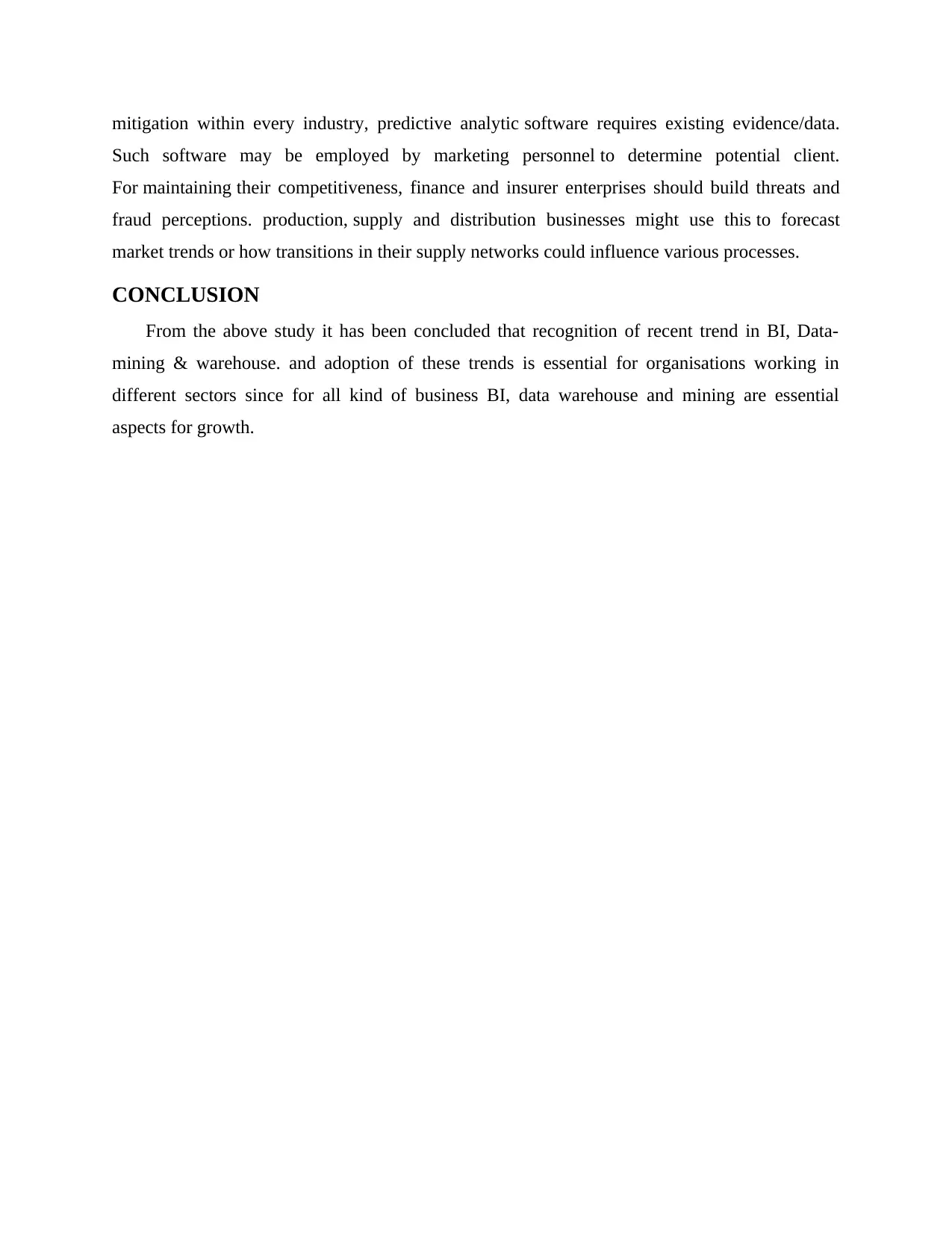
mitigation within every industry, predictive analytic software requires existing evidence/data.
Such software may be employed by marketing personnel to determine potential client.
For maintaining their competitiveness, finance and insurer enterprises should build threats and
fraud perceptions. production, supply and distribution businesses might use this to forecast
market trends or how transitions in their supply networks could influence various processes.
CONCLUSION
From the above study it has been concluded that recognition of recent trend in BI, Data-
mining & warehouse. and adoption of these trends is essential for organisations working in
different sectors since for all kind of business BI, data warehouse and mining are essential
aspects for growth.
Such software may be employed by marketing personnel to determine potential client.
For maintaining their competitiveness, finance and insurer enterprises should build threats and
fraud perceptions. production, supply and distribution businesses might use this to forecast
market trends or how transitions in their supply networks could influence various processes.
CONCLUSION
From the above study it has been concluded that recognition of recent trend in BI, Data-
mining & warehouse. and adoption of these trends is essential for organisations working in
different sectors since for all kind of business BI, data warehouse and mining are essential
aspects for growth.
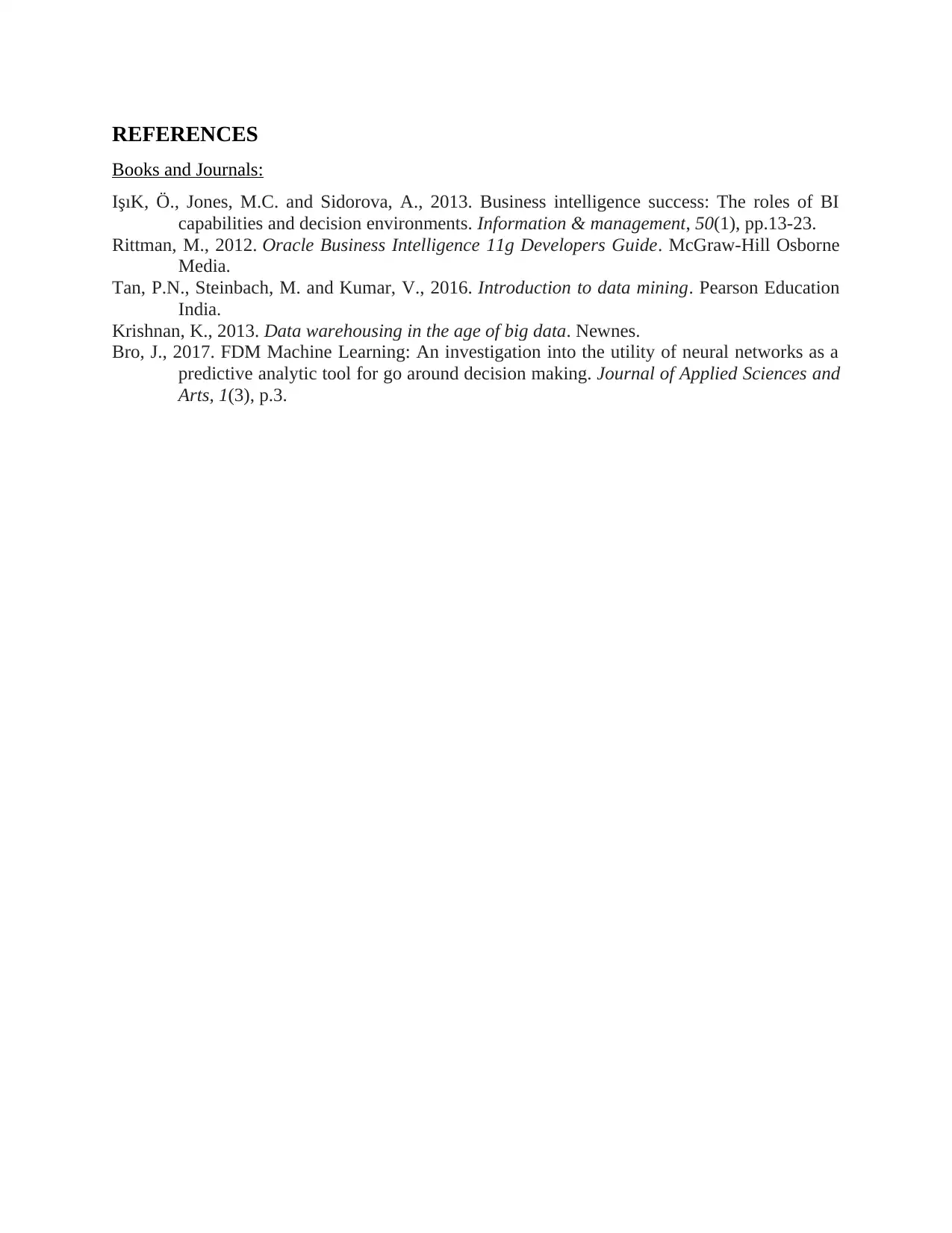
REFERENCES
Books and Journals:
IşıK, Ö., Jones, M.C. and Sidorova, A., 2013. Business intelligence success: The roles of BI
capabilities and decision environments. Information & management, 50(1), pp.13-23.
Rittman, M., 2012. Oracle Business Intelligence 11g Developers Guide. McGraw-Hill Osborne
Media.
Tan, P.N., Steinbach, M. and Kumar, V., 2016. Introduction to data mining. Pearson Education
India.
Krishnan, K., 2013. Data warehousing in the age of big data. Newnes.
Bro, J., 2017. FDM Machine Learning: An investigation into the utility of neural networks as a
predictive analytic tool for go around decision making. Journal of Applied Sciences and
Arts, 1(3), p.3.
Books and Journals:
IşıK, Ö., Jones, M.C. and Sidorova, A., 2013. Business intelligence success: The roles of BI
capabilities and decision environments. Information & management, 50(1), pp.13-23.
Rittman, M., 2012. Oracle Business Intelligence 11g Developers Guide. McGraw-Hill Osborne
Media.
Tan, P.N., Steinbach, M. and Kumar, V., 2016. Introduction to data mining. Pearson Education
India.
Krishnan, K., 2013. Data warehousing in the age of big data. Newnes.
Bro, J., 2017. FDM Machine Learning: An investigation into the utility of neural networks as a
predictive analytic tool for go around decision making. Journal of Applied Sciences and
Arts, 1(3), p.3.
1 out of 7
Related Documents
Your All-in-One AI-Powered Toolkit for Academic Success.
+13062052269
info@desklib.com
Available 24*7 on WhatsApp / Email
![[object Object]](/_next/static/media/star-bottom.7253800d.svg)
Unlock your academic potential
© 2024 | Zucol Services PVT LTD | All rights reserved.





